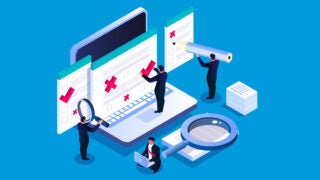USC experts discuss Northridge quake 25th anniversary
The Northridge earthquake struck Southern California 25 years ago, toppling buildings and conventional knowledge of seismic safety. The magnitude 6.7 temblor on Jan. 17, 1994, collapsed buildings and freeways, killing at least 57 people and causing billions of dollars in damage. USC experts examine lessons learned from one of the costliest disasters in U.S. history and tell us how to prepare for the next big quake.
Contact: Gary Polakovic (213) 740-9226 or polakovi@usc.edu
John Vidale, professor of Earth sciences, USC Dornsife College of Letters, Arts and Sciences
“Since the Northridge quake, we’ve been doing most of the right things, such as fixing weaknesses in old buildings. But we need more improvements in the building code, hazard maps and faster early warning systems,” Vidale said.
Noteworthy:
- Quake warnings via mobile apps, such as ShakeAlertLA, are here, but require faster phone systems to become truly effective.
- Northridge showed quakes beget nearby quakes, loading stress onto adjoining faults — a key to building better hazard maps.
- Big quakes reveal underappreciated collateral hazards, including landslides or tsunamis.
Vidale is the former director of the Southern California Earthquake Center (SCEC) at USC and a member of the National Earthquake Prediction Evaluation Council. He’s an expert in seismology, quake forecasting and seismic hazards.
Contact: seismoguy@mac.com or 310-210-2131
Christine Goulet, executive science director for special projects at SCEC at USC.
“The Northridge quake occurred on an unknown fault, so we’ve learned there’s a lot more faults in Southern California. Today, we assume a m6.5 quake could occur anywhere and we account for this in the hazard assessment,” Goulet said.
Noteworthy:
- The L.A. basin is a sediment-filled rock bowl. Subterranean features at the edge of the bowl can amplify and concentrate strong shaking, causing severe, localized damage.
- Violent shaking affects soft soils, toppling structures in one locale while leaving intact similar nearby structures.
- New models developed since Northridge account for vulnerable soil conditions. Said Goulet: “If you can more accurately predict how the ground will shake, you can design structures better.”
- Northridge revealed quake-vulnerable buildings, including apartments built atop poorly supported parking spaces, as well as some concrete structures and steel-frame buildings.
Goulet leads interdisciplinary teams that find ways to reduce quake risks. She’s an expert in applied seismology, strong ground motion and how quakes affect structures.
Contact: cgoulet@usc.edu or (213) 821-3904 or (310) 980-6348
Gregg Brandow, professor of engineering practice, USC Viterbi School of Engineering.
“The damage to steel frame buildings was a big shock to engineers after the Northridge earthquake. We thought steel frame buildings, including high-rises, were ductile, but they proved brittle. Many are vulnerable, especially if we get a big quake on a big fault because it will shake much longer than Northridge did and damage will be greater,” Brandow said.
Noteworthy:
- New high-rise building construction has improved since Northridge, but welds in older steel frame buildings remain a concern.
- Local ordinances have led to retrofits for some classes of buildings — unreinforced masonry and residential buildings — but not so much for others, such as old concrete buildings. Said Brandow: “We are just starting to retrofit some of these buildings across L.A.”
- Preparation pays, so bolt older homes to foundations and anchor chimneys. Store water and food and make plans to adapt to potential loss of utilities, shelter and business.
Brandow is a licensed civil and structural engineer with more than 40 years of experience. He specializes in structural design and earthquake engineering. He is the past president of Brandow & Johnston, a L.A-based firm that designs big buildings in the region, and now a principal in the Brandow & Nastar, Inc.
Contact: brandow@usc.edu or (213) 399-3797
Adam Rose, research professor, USC Price School of Public Policy, and faculty affiliate of the Center for Risk and Economic Analysis of Terrorism Events (CREATE) at USC.
“Northridge was an important event because it got people back to thinking seriously about earthquakes as the first major quake in the L.A. area since 1971,” Rose said.
Noteworthy:
- Northridge resulted in an estimated $35 billion in property damage, one of the nation’s biggest disasters at that time. Damage costs would likely triple in a major quake on the southern San Andreas Fault, such as the ShakeOut Scenario. Said Rose: “Northridge woke people up to the extent of damage that can occur in an urban center.”
- Quake mitigation pays. Every $1 spent on quake mitigation yields $3 in economic benefits by way of reduced property damage, lives saved and business interruption prevented.
- Economic losses from business interruption mount if recovery is prolonged after big disasters. Thus, resilience planning and improvisation — the “bounce-back” strategy to sustain economic activity after a quake — is critical to reducing losses.
Rose is an expert in the economics of disasters, including earthquakes. He’s served as the lead economist on the U.S. Geological Survey disaster scenarios, including the Great California Shake Out, and lead researcher for a report to Congress on the net benefits of the Federal Emergency Management Agency hazard mitigation grants.
Contact: adamzros@price.usc.edu or (814) 777-6789
Raj Dasgupta, assistant professor of clinical medicine at the Keck School of Medicine of USC.
“The Northridge quake raised awareness of Valley Fever. It occurs under the right geography in a place that has a certain fungus in the soil. Nothing disrupts soil more than having tectonic plates crash into each other, which puts a lot of dust in the air,” Dasgupta said.
Noteworthy:
- Valley Fever is an acute infection caused by a fungus, Coccidioides.The fungus releases spores when land is tilled, bulldozed or shaken; people inhale them via dust.
- Symptoms include chest pains, coughing, night sweats, fatigue, chills and occasional rash.
- About 10,000 cases of Valley Fever are reported annually, mostly in California, according to the U.S. Centers for Disease Control and Prevention.
- About 200 cases of Valley Fever were reported soon after the Northridge quake.
Dr. Dasgupta is an expert in pulmonary care, critical care and cardiovascular complications. He specializes in pulmonology and is the assistant program director of the Department of Internal Medicine at the Keck School of Medicine.
Contact: rdasgupt@usc.edu (323) 442-5306 or (616) 780-3175
Photo caption: A portion of the Golden State Freeway collapsed during the 1994 Northridge earthquake.
Photo credit: (Photo/Robert A. Eplett, FEMA)



